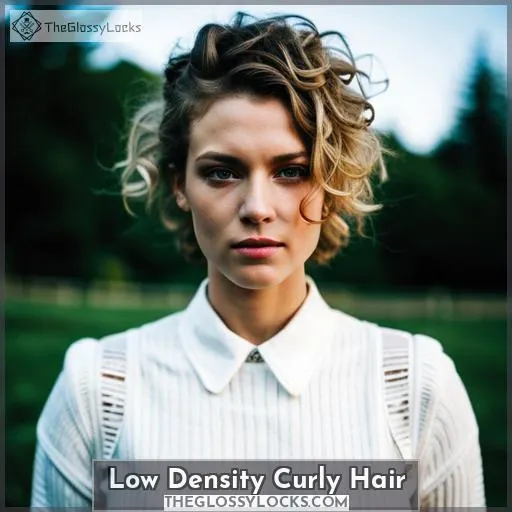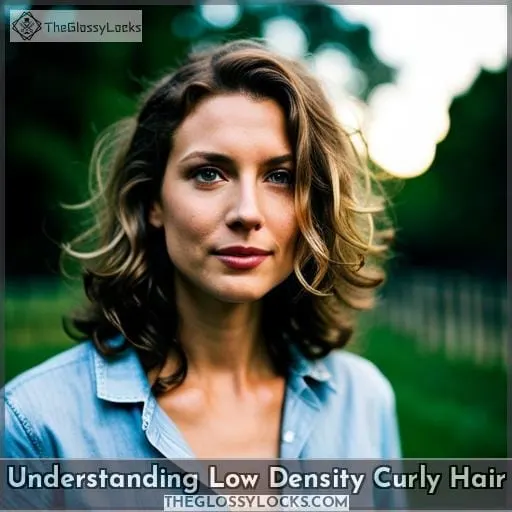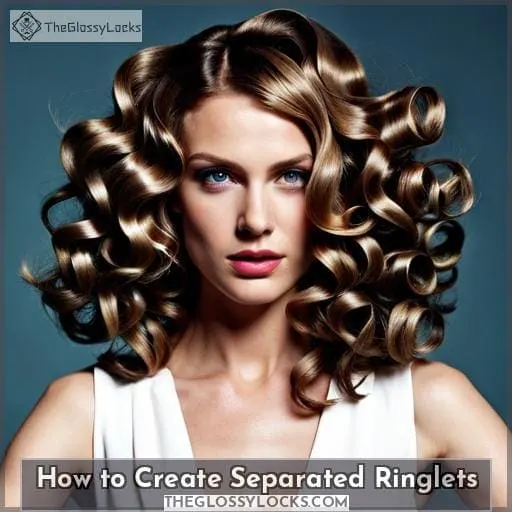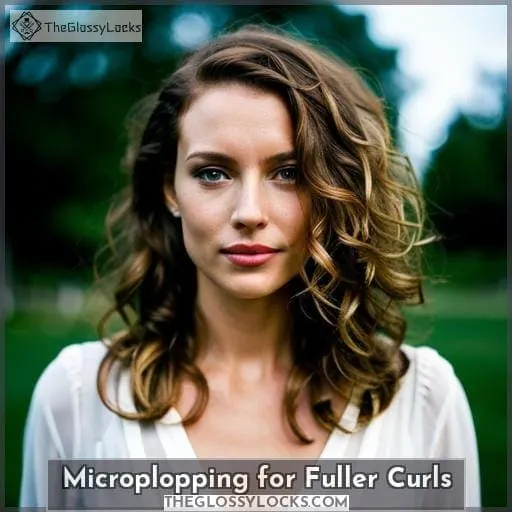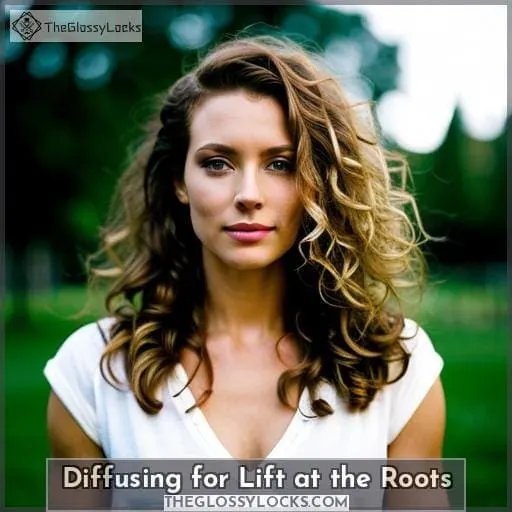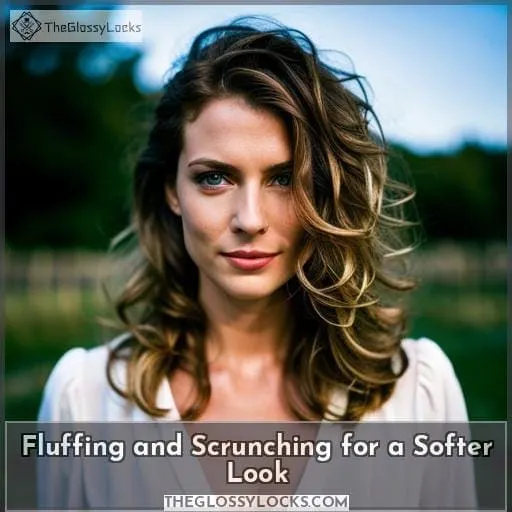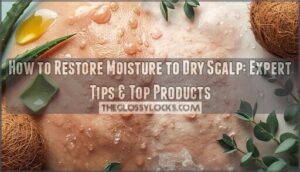This site is supported by our readers. We may earn a commission, at no cost to you, if you purchase through links.
Have you ever wondered why your curls are thinner than the rest? Is it possible to make them thicker and more voluminous? Well, if so, then this article is for you.
Low density curly hair can be a tricky thing to manage – but don’t worry! We’ll take you through the dos and don’ts of styling low density curls so that no matter how thin they may seem at first glance, we guarantee that with a little bit of effort your ringlets will be as full as any other head of hair.
So put on your thinking cap; let’s dive into understanding low-density curly hair like a duck takes to water!
Table Of Contents
- Key Takeaways
- Understanding Low Density Curly Hair
- The Difference Between Texture and Density
- Dos and Don’ts for Styling Low Density Curls
- How to Create Separated Ringlets
- Microplopping for Fuller Curls
- Diffusing for Lift at the Roots
- Fluffing and Scrunching for a Softer Look
- Recommended Products for Low Density Curly Hair
- Frequently Asked Questions (FAQs)
- How can I tell if I have low density curly hair?
- What are the best hairstyles for low density curly hair?
- Are there any products specifically designed for low density curly hair?
- Are there any special techniques for styling low density curly hair?
- What is the best way to keep my low density curly hair healthy?
- Conclusion
Key Takeaways
- Understanding the difference between texture and density is crucial for proper styling techniques for low density curly hair.
- Protective styling, healthy hair habits, and protein treatments can help maintain moisture balance and strengthen fine strands.
- Using lightweight products such as curl creams or leave-ins and volumizing techniques can add body and definition without weighing down curls.
- Microplopping, diffusing, and fluffing and scrunching techniques can help create lift and softness for low density curly hair.
Understanding Low Density Curly Hair
You’ve got low density curly hair, and you know it can be a challenge to maintain.
Protective styling helps keep moisture balance in check for curl definition without damaging fine strands. When selecting products, look for lightweight formulas that won’t weigh down thin hair or create buildup on the scalp.
The Curly Girl Method is also great as it focuses on healthy habits like no-poo cleansers and deep conditioning treatments while embracing natural curl patterns.
If you need help getting started or want to learn more about caring for low density curly hair specifically, we’ve got just the thing – our free email course offers simple tips plus an exclusive Quick Start Guide to Mastering Your Curls!
The Difference Between Texture and Density
Understanding your hair is key to finding the right styling techniques, and it all starts with learning the difference between texture and thickness. Be sure to feel out each strand! Texture types refer to how thick or thin individual strands of hair are.
Density levels, on the other hand, describe how many hairs per square inch lie on top of your scalp.
If you have low density curly hair, this means that you may experience visible scalp even when dry. To accommodate for this, utilize a Hair Buff after washing day as well as protein treatments every now and then in order to strengthen fine hairs from breakage while providing extra volume where needed.
You can also use lightweight products such as curl creams or leave-ins rather than heavy butters or oils which can weigh down curls more quickly than usual due to their delicate nature.
Lastly, remember there’s no ‘one size fits all’ approach for curly girl journeys, so trust yourself enough in knowing what works best for YOUR unique low density locks – experiment away until success is achieved!
Dos and Don’ts for Styling Low Density Curls
When it comes to styling low density curls, there are some dos and don’ts that you should keep in mind. Pre-poo oil is an important step in the process as it helps protect your hair from damage caused by shampooing.
When choosing a shampoo and deep conditioner, make sure they are formulated for curly hair so that you can reap all the benefits this type of product has to offer.
Pre-poo Oil
Start your styling journey with a pre-poo oil to protect fragile strands and keep curls bouncy, soft, and shiny. Curly care requires the right product choice, as using too much can weigh down low-density hair.
For best results when cleansing hair healthily before applying pre-poo oil, use lathering shampoo instead of co-washing. A volumizing mousse or gel is great for adding lift at roots while wet to increase volume boost on fine curly hair without weighing it down further.
Delilah Orpi’s Quick Start Guide helps you make the most of your individual curl type through her expert styling tips.
Shampoo and Deep Conditioner
To achieve healthy, voluminous curls, choose a lightweight shampoo and deep conditioner that nourish your delicate tresses.
Deep conditioning treatments can help provide extra moisture and protein to fine curly hair. Hair buffs are also great for adding volume without weighing down the hair, while dry shampoo helps extend wash days between shampoos.
Using an absorbent towel like the HairRepear Ultimate Towel can make drying much easier, as it prevents too much moisture from being absorbed into low density strands – something the hair likes less of!
By using lightweight products such as curl cream or leave-in conditioners with thinner gel formulas or mousse, you will have an easier time styling your curls without them becoming heavy and weighed down by product buildup.
Styling Products
Choose the right styling products for your type of curls to get bouncy, voluminous locks – lightweight creams and gels are key! If you have fine curly hair, it means that each strand is thin on its own.
To avoid weighing down those strands with heavy product, opt for cleansing alternatives like low poo shampoo or protein treatments instead.
Volumizing routines can also help give more body to a smaller area of curls. Dry shampoo and a hair buffing technique can make all the difference in achieving this look. Don’t forget about scrunching techniques too! Each weather condition calls for different products, so be sure to experiment until you find what works best in any given situation.
Styling Techniques
You can use styling techniques to create voluminous, bouncy curls with your fine hair. Microplopping and diffusing your hair completely dry helps reduce weight on the strands while adding body at the roots.
It’s a good idea to select lightweight products that won’t weigh down thin strands, use a styling brush for separated ringlets or finger coils, and switch up methods often for best results. Additionally, using protein treatments will strengthen fragile locks, as well as investing in quality towels or a hair buff, which help keep much-needed moisture in curly locks.
How to Create Separated Ringlets
Using a styling brush, create beautiful ringlets to give your hair an extra boost of fullness and lift. For low-density curls, dry detangling is key before beginning any styling process. Moistening the hair can cause it to clump together into larger sections which weigh down the little fine hairs.
Product selection should focus on lightweight products that won’t add too much weight while providing moisture and definition. The brushing technique should be done gently to prevent breakage and split ends.
Incorporating protein treatments into your routine every few weeks will help strengthen the thin strands of coarse low-density hair, ensuring their longevity over time.
Microplopping for Fuller Curls
Try microplopping to achieve voluminous, bouncy curls in a fraction of the time – up to 60% faster than diffusing! Microplopping is an ideal styling technique for those with low density curly hair. This method helps reduce weight from wet strands and creates more definition and volume.
To get the most out of your style, give yourself a thorough cleansing using low poo shampoo or dry shampoo followed by protein treatments as needed. For extra lift at roots, use a hair buff or fluffing brush before applying stylers like curl cream or mousse.
When finished, direct hair away from the scalp and pick up horizontal sections at the crown for fullness without weighing down thin individual strands too much.
Finally, apply very small amounts of product throughout your locks until the desired look is achieved.
Diffusing for Lift at the Roots
Differentiate your curls with some lift at the roots by diffusing them completely dry! To get that extra oomph, follow these steps:
- Start off by following the Curly Girl Method and using lightweight products.
- Protein treatments are essential to strengthen fine hair strands and prevent breakage in order for them to hold their shape better when styling with heat tools like a diffuser.
- Hair buffs help create a lot of length while also hiding scalp visibility – one of the biggest issues low density curly-haired people face in day-to-day life! Make sure you use this before blow-drying or styling with any other heated tool around your head area.
- A volumizing routine is key for low-density hair – try switching out heavy butters and oils for light leave-ins if needed, as well as adding an additional element such as dry shampoo which can add texture without weighing down thin individual strands even more than usual on second-time applications throughout each week until the desired look is achieved.
- Lastly, make sure you’re flipping your part every day so that each side gets equal amounts of love from products used prior to styling – this will ensure maximum volume throughout all sections once finished! With these tips in mind, getting those voluminous locks won’t be too much trouble after all!
Fluffing and Scrunching for a Softer Look
Scrunching and fluffing your curls can help achieve a softer, fuller look. When working with low-density hair, avoid products that are too heavy or thick as they weigh down the hair. Use lightweight curl creams or leave-ins for extra moisture and thin gels or mousse to create definition without weighing down the curls.
Hair buffs are great tools for creating lift at the roots. Use them when dry shampoo is not enough! Protein treatments also strengthen fine strands, so try adding these into your routine once in a while.
Microplopping instead of plopping/diffusing on soaking wet hair is an effective way to reduce the weight of water on low-density locks. This technique creates volume at the root level, which helps disguise any scalp visibility issues you may have experienced previously.
With all these tips combined, you should be able to successfully style your beautiful curly mane without losing out on volume!
Recommended Products for Low Density Curly Hair
Finding the right products for your fine curly hair can help you achieve volume and manageability, while avoiding weighing it down. For low density curls, lightweight styling products are key. Look out for curl creams or leave-ins with a light feel that won’t weigh down your strands.
Incorporate volumizing into your routine by using mousse or gels in thin formulas. Apply them away from the roots of your hair before directing up and away from the scalp when styling.
Dry shampoo is also great for adding texture between washes without overloading on product. Hair Buffs work wonders too! Utilize Delilah Orpi’s Curly Girl Method as well as her Quick Start Guide, Mastering Your Curls, for further tips regarding embracing natural wavy/curly locks.
Frequently Asked Questions (FAQs)
How can I tell if I have low density curly hair?
To determine if you have low-density curly hair, measure the circumference of your dry hair when gathered into a ponytail. If it is less than 2 inches around, then you likely have low-density curls. Look for thin strands that are hard to feel between your fingers and may be difficult to see.
What are the best hairstyles for low density curly hair?
Hairstyles that work best for low density curly hair are those that lift the curls away from the scalp, such as microplopping and diffusing with dry hair. Lightweight products should be used to define curls while keeping volume, and large clumps of curls should be broken up into smaller sections.
Are there any products specifically designed for low density curly hair?
Yes, there are products specifically designed for low-density curly hair. Look for lightweight formulas that won’t weigh down your curls and volumizing products to add body. Try protein treatments, dry shampoo, and a buff brush too! Embrace natural wavy/curly locks with an expert-guided course or blog posts about fine curly hair care.
Are there any special techniques for styling low density curly hair?
Yes, there are special techniques for styling low-density curly hair. These techniques include using lightweight products, separating the hair into smaller clumps, microplopping, and diffusing with dry hair.
Additionally, there are various volumizing tricks that can create fuller-looking curls that last longer.
What is the best way to keep my low density curly hair healthy?
To keep your low density curly hair healthy, use lightweight products, deep condition regularly, and avoid heavy styling methods. Try volumizing techniques such as microplopping or dry shampoo to add fullness. Look for products specifically designed for low density curly hair to help you achieve a healthy and lustrous look.
Conclusion
Low density curly hair is beautiful and should be embraced. With the right products and styling techniques, you can create the soft, bouncy curls of your dreams. Achieving volume is possible with the right products and techniques, such as pre-poo oil, lightweight styling creams, microplopping, and diffusing.
Fluffing and scrunching your hair can help create softness and definition. With a few simple steps, you can give your curls the life they deserve.

